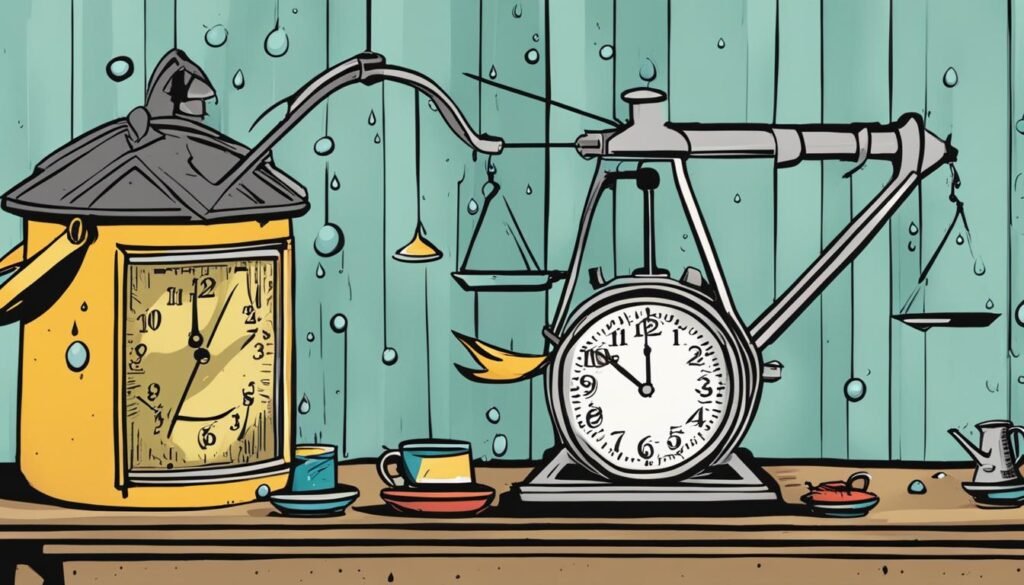Sarcasm is a linguistic technique that adds a touch of humor and wit to everyday conversations. It involves saying the opposite of what you actually mean, often in a sarcastic tone. Mastering the art of sarcasm can help you engage in playful banter and create a lighthearted atmosphere. In this guide, we will explore the different uses of sarcasm, provide examples, and offer tips for understanding and using sarcasm effectively.
Key Takeaways:
- Sarcasm adds humor and wit to conversations.
- It involves saying the opposite of what you mean in a sarcastic tone.
- Mastering sarcasm can help you engage in playful banter.
- Understanding sarcasm requires practice and an understanding of social cues.
- Using sarcasm appropriately and with moderation is key.
Using Sarcasm to Express Ideas or Comment on Events
Sarcasm is a versatile linguistic tool that allows you to express irony, make comments on various ideas or events, and inject humor into everyday conversations. By utilizing a sarcastic tone and emphasizing specific words, you can convey the opposite of what is being said. For example, after watching a particularly dull film, you might sarcastically exclaim, “Well, that was fun!” This sarcastic remark adds a comedic element to the conversation, highlighting your dissatisfaction with the movie while engaging those around you in playful banter.
It is crucial to use sarcasm deliberately and ensure that your intended meaning is clear without causing confusion or offense. Sarcasm can be a powerful tool for expressing opinions or commentary, but it requires finesse and awareness of your audience. Taking into account the context and the people you are communicating with is essential to avoid misunderstandings. Striking the right balance and using sarcasm effectively will allow you to convey your thoughts in a lighthearted and humorous manner.
Remember, sarcasm is not meant to be offensive or hurtful. It should be used as a playful form of communication that adds wit and humor to your conversations. By understanding the definition of sarcasm and adopting a sarcastic tone when appropriate, you can effectively express ideas, comment on events, and create an engaging atmosphere where everyone can join in the fun. So, feel free to add a touch of sarcasm to your daily interactions and enjoy the delightful banter it brings!

Examples of Sarcasm in Expressing Ideas or Commenting on Events
- Person A: “I love waking up early on weekends!”
Person B: “Oh, absolutely! It’s the highlight of my day.” - Person A: “Can you believe we have another work meeting today?”
Person B: “Oh, I’m thrilled! I couldn’t wait to sit through another riveting PowerPoint presentation.” - Person A: “This traffic jam is fantastic!”
Person B: “Oh, yes, it’s pure bliss. I love spending extra time in my car.”
| Situation | Sarcastic Comment |
|---|---|
| After a long day at work | “Wow, that was a super productive day!” |
| When someone spills coffee on their shirt | “Great job! You’re really nailing this whole ‘not making a mess’ thing.” |
| On a hot summer day | “Oh, I just can’t get enough of this scorching heat!” |
“Sarcasm is a way of saying one thing and meaning another, while also conveying contempt or mockery. It adds a touch of humor to our daily conversations and allows us to express our thoughts in a lighthearted manner. Just remember to use sarcasm responsibly and consider your audience to ensure it is well-received.”
Criticizing Obvious Comments with Sarcasm
Sarcasm can be a powerful tool to mock and criticize obvious comments or unnecessary analysis. When someone states the obvious, you can respond with sarcastic remarks to highlight the lack of insight. This form of sarcasm allows you to playfully point out the obviousness in a lighthearted and humorous way.
For instance, imagine you are having a conversation with a friend during a heavy rainstorm, and they say, “It’s raining.” In such a situation, you can use sarcasm to respond with a witty remark like, “Oh, is it? I hadn’t noticed.” This sarcastic comeback serves to subtly underline the redundancy of their statement.
However, it is important to strike a balance with sarcasm and not overuse it to avoid offending others. While sarcastic replies can be amusing, it’s crucial to consider the feelings and reactions of those around you. Gauge the tolerance level of your conversation partner and be mindful of using sarcasm in appropriate contexts and with the right audience.

Examples of Sarcastic Remarks
“Wow, what a groundbreaking discovery!”
“Well, thank you, Captain Obvious!”
“You must be a genius to figure that out.”
Highlighting Predictable Events with Sarcasm
Sarcasm can be a powerful tool for drawing attention to predictable or expected events, adding a touch of humor to everyday conversations. By using a sarcastic tone and clever remarks, you can highlight situations that are so obvious they practically beg for a sarcastic response.
For example, imagine your friend tells you about a coworker who always arrives late to meetings. With a sarcastic tone, you could say, “Oh, what a surprise” or “That’s shocking, I never would have guessed.” These sarcastic comments serve to emphasize the predictability of the situation and can create a lighthearted atmosphere.
Using sarcasm in this way allows you to playfully acknowledge the lack of surprise without causing offense. It adds a humorous twist to conversations and can help you connect with others through shared experiences and observations.
The Art of Predictability
When employing sarcasm to highlight predictable events, it’s important to strike the right balance. Use it sparingly and only when appropriate to prevent it from becoming repetitive or tiresome. Remember to consider the context and the person you’re speaking with to ensure your sarcasm is well-received.
| Event | Sarcastic Comment |
|---|---|
| Someone spills their coffee | “Well, that’s unexpected.” |
| A colleague forgets their lunch | “Oh, what a shocker.” |
| Your friend cancels plans last minute | “Wow, I totally didn’t see that coming.” |
By using sarcasm to highlight predictable events, you can inject humor into everyday situations and create a more engaging and enjoyable social dynamic. Remember to use sarcasm wisely and always consider the feelings and reactions of those around you.
Using Sarcasm to Playfully Chide Mistakes
Sarcasm can be a powerful tool for playfully teasing or chiding someone’s mistakes. By using a sarcastic tone, you can point out errors or mishaps in a humorous way, fostering a lighthearted atmosphere. However, it’s important to exercise caution and ensure that the person you are teasing is comfortable with sarcasm, as it can potentially offend or upset others.
When using sarcasm to chide mistakes, the key is to strike a balance between humor and consideration. Make sure the person understands that your remarks are meant in good fun and not meant to belittle or demean them. For example, imagine your friend accidentally spills their coffee all over themselves. You could playfully say, “Nice job, graceful as always!” to lighten the mood and make them laugh.
Remember, sarcasm should never be used with malicious intent or to target someone’s insecurities. It’s important to know your audience and gauge their reaction before using sarcasm. If you sense that the person may not appreciate sarcasm or could be sensitive about the mistake they made, it’s best to find a different approach to address the situation.
Overall, using sarcasm to playfully chide mistakes can add an element of humor to everyday blunders. Just be mindful of the individual’s comfort level and ensure that your sarcastic remarks are delivered with a friendly and lighthearted tone.

Table: Examples of Playful Sarcasm in Chiding Mistakes
| Mistake | Sarcastic Chide |
|---|---|
| Spilling coffee | Nice job, graceful as always! |
| Forgetting an umbrella in the rain | Oh, brilliant move! Who needs an umbrella? |
| Burning dinner | Congratulations, you’ve mastered the art of culinary disasters! |
Expressing Pretend Pleasure or Thankfulness with Sarcasm
Sarcasm can be a powerful tool for expressing pretend pleasure or thankfulness in unfortunate situations. By using a sarcastic tone, you can convey the opposite emotions and inject humor into otherwise disappointing or frustrating circumstances. This type of sarcasm allows you to cope with setbacks or disappointments by finding amusement in the irony of the situation.
For example, imagine receiving a bad grade on a test. Instead of dwelling on the disappointment, you might sarcastically say, “Oh, wonderful! I really needed this to brighten up my day!” This type of sarcastic response highlights your true feelings of frustration while also adding a touch of humor.
Sarcasm can also be used to express pretend thankfulness in situations where gratitude may not be the genuine emotion. Let’s say you receive an unwanted gift. Instead of showing dissatisfaction, you can use sarcasm to express your appreciation ironically. For instance, you might sarcastically remark, “Oh, thank you so much for this utterly unnecessary item. I can’t wait to cherish it forever!” This type of sarcastic response allows you to acknowledge the gesture while also conveying your true feelings in a lighthearted manner.
Examples of Sarcastic Quotes:
“Oh, congratulations! You’ve managed to exceed my already low expectations.”
“Thank you, Captain Obvious, for enlightening us with your profound wisdom.”
“Well, that was a brilliant idea. What could possibly go wrong?”
Remember, sarcasm should be used sparingly and with caution. While it can add humor to certain situations, using sarcasm excessively or inappropriately may offend or confuse others. Consider the context and the sensibilities of those around you before employing sarcasm, and ensure that your intent is clear to avoid misunderstandings.
Applying Old-Fashioned Language in Sarcasm
Making use of old-fashioned language can be an effective way to add a subtle layer of sarcasm to your conversations. By using words or phrases such as “gosh” or “golly” before making a sarcastic comment, you can clarify that you are being sarcastic. For example, if someone says, “We’re going to be late,” you might sarcastically respond, “Gosh, you don’t say?” This style of sarcasm adds a playful and nostalgic quality to your remarks.
Old-fashioned language in sarcasm not only serves as a verbal cue but also enhances the comedic effect. It creates a stark contrast between contemporary language and antiquated expressions, making the sarcasm more noticeable and amusing. When used appropriately, this type of language can evoke laughter and create an engaging atmosphere in conversations.
Remember, when using old-fashioned language in sarcasm, it’s important to strike a balance. Overusing it can diminish the impact and make it appear forced or insincere. Use it sparingly and when the situation calls for it, so as not to dilute its effectiveness and keep the element of surprise intact.
Examples:
- “Oh, for Pete’s sake! You’re a real genius, aren’t you?”
- “Well, isn’t this just peachy? All my plans have fallen through.”
- “Oh, what a splendid idea! Let’s add even more work to our already overflowing plates.”
By incorporating old-fashioned language into your sarcastic remarks, you can elevate the wit and charm of your humor. Remember to use it wisely and have fun experimenting with different phrases to add a touch of nostalgia to your sarcasm.

Considering the Context and Audience for Sarcasm
When it comes to using sarcasm effectively, understanding the context and audience is essential. Sarcasm can be a fun and playful way to add humor to conversations, but it’s important to consider how it will be received by others.
First, think about the context in which you’re using sarcasm. In more informal settings, like among friends or in casual conversations, sarcasm is often well-received and can create a lighthearted atmosphere. However, in professional settings or with people you don’t know well, sarcasm may not be as appropriate. It’s crucial to have a good understanding of the situation and the people involved before using sarcasm.
Additionally, consider your audience’s tolerance for sarcasm. While some people may enjoy and appreciate sarcastic remarks, others may find them confusing or offensive. Gauge the reactions of those you’re speaking with and adjust your level of sarcasm accordingly. And always be mindful of sensitive topics or individuals who may not appreciate sarcasm.
By taking the time to consider the context and audience for your sarcasm, you can use this linguistic technique effectively and ensure that your humor is well-received.
| Context | Audience | Appropriateness |
|---|---|---|
| Informal settings | Friends, casual conversations | Well-received, creates a lighthearted atmosphere |
| Professional settings | Colleagues, clients, superiors | May not be as appropriate, gauge the situation before using sarcasm |
| People you don’t know well | Acquaintances, new connections | Exercise caution, sarcasm may not be well-received |
| Sensitive topics | Individuals with strong opinions or emotions | Avoid sarcasm on sensitive subjects to prevent offense |
The Art of Timing and Moderation in Sarcasm
Timing and moderation are crucial when it comes to using sarcasm effectively. While sarcasm can add humor and wit to conversations, overusing it can make others feel uncomfortable or annoyed. It’s important to strike a balance between making clever sarcastic remarks and ensuring that people still feel at ease around you.
One of the key aspects of timing in sarcasm is choosing the right moment to deliver your sarcastic comment. Pay attention to the flow of the conversation and wait for an opportune time to interject with your witty remark. This can help create a natural and seamless transition that maximizes the impact of your sarcasm.
Moderation is equally important in using sarcasm effectively. Don’t rely solely on sarcasm to communicate your thoughts or opinions. Instead, use it sparingly to add a touch of humor and playfulness to the conversation. By doing so, you can ensure that your sarcasm remains fresh and unexpected, keeping your audience engaged and entertained.
Remember, if you feel that sarcasm is becoming repetitive or tiresome, you can always tap into your wit and cleverness to keep the conversation lively. Sarcasm is just one tool in your communication arsenal, and using it in moderation can help you build stronger relationships and foster a lighthearted atmosphere.

Conclusion
Sarcasm is truly an artform that requires practice, timing, and a deep understanding of social cues. By mastering the art of sarcasm, you can unlock the power to engage in playful banter, add a touch of humor to conversations, and build stronger relationships.
Remember, the key to using sarcasm effectively lies in using it appropriately and in moderation. While sarcasm can be humorous, it’s important to strike a balance and ensure that others still feel comfortable and at ease in your presence. Being mindful of the feelings and reactions of those around you is crucial.
With dedication and practice, you can become a true master of sarcasm. By using this linguistic technique in a friendly and lighthearted manner, you’ll be able to create a joyful atmosphere and become a witty conversationalist. So go ahead, embrace the art of sarcasm and let your wit shine!
FAQ
What is sarcasm?
Sarcasm is a linguistic technique that involves saying the opposite of what you actually mean, often in a sarcastic tone.
How can sarcasm be used to express ideas or comment on events?
By using a sarcastic tone and emphasizing certain words, you can convey the opposite of what is being said, expressing irony or making a comment on certain ideas or events.
How can sarcasm be used to criticize obvious comments?
Sarcasm can be used to highlight the lack of insight in obvious comments and add a humorous twist to the conversation.
In what situations can sarcasm be used to highlight predictable events?
Sarcasm can be used to comment on situations that are not surprising, adding a humorous twist and lightening the mood.
How can sarcasm be used to playfully chide someone’s mistakes?
By using a sarcastic tone, you can point out errors or mishaps in a humorous way, as long as the person you are teasing is comfortable with sarcasm.
How can sarcasm help express pretend pleasure or thankfulness in unfortunate situations?
Sarcasm can be used to convey the opposite emotions in disappointing or frustrating situations, adding a touch of humor.
How can old-fashioned language enhance sarcasm?
Using words or phrases such as “gosh” or “golly” before making a sarcastic comment can add a playful and nostalgic quality.
When should I consider using sarcasm?
It is important to consider the context and audience before using sarcasm, as different people have varying reactions to it. It’s best to gauge the tolerance level of your conversation partner and avoid using sarcasm in professional settings or with individuals who may not appreciate your sense of humor.
What is the key to using sarcasm effectively?
Timing and moderation are crucial when using sarcasm. While it can be humorous, overusing it can make others feel uncomfortable or annoyed. Find the balance between making witty remarks and ensuring that people feel comfortable around you.
How can I unlock the art of sarcasm?
Practice, timing, and an understanding of social cues are essential to mastering the art of sarcasm. With time and experience, you can become a witty conversationalist and use sarcasm effectively.
